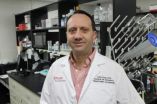(Press-News.org) CAMBRIDGE, MA -- Cancer rates in developing nations have climbed sharply in recent years, and now account for 70 percent of cancer mortality worldwide. Early detection has been proven to improve outcomes, but screening approaches such as mammograms and colonoscopy, used in the developed world, are too costly to be implemented in settings with little medical infrastructure.
To address this gap, MIT engineers have developed a simple, cheap, paper test that could improve diagnosis rates and help people get treated earlier. The diagnostic, which works much like a pregnancy test, could reveal within minutes, based on a urine sample, whether a person has cancer. This approach has helped detect infectious diseases, and the new technology allows noncommunicable diseases to be detected using the same strategy.
The technology, developed by MIT professor and Howard Hughes Medical Institute investigator Sangeeta Bhatia, relies on nanoparticles that interact with tumor proteins called proteases, each of which can trigger release of hundreds of biomarkers that are then easily detectable in a patient's urine.
"When we invented this new class of synthetic biomarker, we used a highly specialized instrument to do the analysis," says Bhatia, the John and Dorothy Wilson Professor of Health Sciences and Technology and Electrical Engineering and Computer Science. "For the developing world, we thought it would be exciting to adapt it instead to a paper test that could be performed on unprocessed samples in a rural setting, without the need for any specialized equipment. The simple readout could even be transmitted to a remote caregiver by a picture on a mobile phone."
Bhatia, who is also a member of MIT's Koch Institute for Integrative Cancer Research and Institute for Medical Engineering and Science, is the senior author of a paper describing the particles in the Proceedings of the National Academy of Sciences the week of Feb. 24. The paper's lead authors are graduate student Andrew Warren, postdoc Gabriel Kwong, and former postdoc David Wood.
Amplifying cancer signals
In 2012, Bhatia and colleagues introduced the concept of a synthetic biomarker technology to amplify signals from tumor proteins that would be hard to detect on their own. These proteins, known as matrix metalloproteinases (MMPs), help cancer cells escape their original locations by cutting through proteins of the extracellular matrix, which normally holds cells in place.
The MIT nanoparticles are coated with peptides (short protein fragments) targeted by different MMPs. These particles congregate at tumor sites, where MMPs cleave hundreds of peptides, which accumulate in the kidneys and are excreted in the urine.
In the original version of the technology, these peptides were detected using an instrument called a mass spectrometer, which analyzes the molecular makeup of a sample. However, these instruments are not readily available in the developing world, so the researchers adapted the particles so they could be analyzed on paper, using an approach known as a lateral flow assay — the same technology used in pregnancy tests.
To create the test strips, the researchers first coated nitrocellulose paper with antibodies that can capture the peptides. Once the peptides are captured, they flow along the strip and are exposed to several invisible test lines made of other antibodies specific to different tags attached to the peptides. If one of these lines becomes visible, it means the target peptide is present in the sample. The technology can also easily be modified to detect multiple types of peptides released by different types or stages of disease.
In tests in mice, the researchers were able to accurately identify colon tumors, as well as blood clots. Bhatia says these tests represent the first step toward a diagnostic device that could someday be useful in human patients.
"This is a new idea — to create an excreted biomarker instead of relying on what the body gives you," she says. "To prove this approach is really going to be a useful diagnostic, the next step is to test it in patient populations."
Developing diagnostics
To help make that happen, the research team recently won a grant from MIT's Deshpande Center for Technological Innovation to develop a business plan for a startup that could work on commercializing the technology and performing clinical trials.
Bhatia says the technology would likely first be applied to high-risk populations, such as people who have had cancer previously, or had a family member with the disease. Eventually, she would like to see it used for early detection throughout developing nations.
Such technology might also prove useful in the United States, and other countries where more advanced diagnostics are available, as a simple and inexpensive alternative to imaging. "I think it would be great to bring it back to this setting, where point-of-care, image-free cancer detection, whether it's in your home or in a pharmacy clinic, could really be transformative," Bhatia says.
With the current version of the technology, patients would first receive an injection of the nanoparticles, then urinate onto the paper test strip. To make the process more convenient, the researchers are now working on a nanoparticle formulation that could be implanted under the skin for longer-term monitoring.
The team is also working to identify signatures of MMPs that could be exploited as biomarkers for other types of cancer, as well as for tumors that have metastasized.
INFORMATION:
The research was funded by a National Science Foundation Graduate Research Fellowship, a Mazumdar-Shaw International Oncology Fellowship, the Ruth L. Kirschstein National Research Service Award from the National Institutes of Health, the Burroughs Wellcome Fund, the National Cancer Institute, and the Howard Hughes Medical Institute.
Written by Anne Trafton, MIT News Office
A paper diagnostic for cancer
2014-02-24
ELSE PRESS RELEASES FROM THIS DATE:
Species conservation poised to benefit from DNA advances
2014-02-24
A biologist at the University of York is part of an international team which has shown that advanced DNA sequencing technologies can be used to accurately measure the levels of inbreeding in wild animal populations.
The research by senior author Dr Kanchon Dasmahapatra, of the Department of Biology at York, and led by Dr Joseph Hoffman, of the Department of Animal Behaviour, Bielefeld University, Germany, may help efforts to conserve rare species.
Laboratory studies show that inbreeding reduces fitness. However, studying the impact of inbreeding in wild populations has ...
Acupuncture holds promise for treating inflammatory disease
2014-02-24
When acupuncture first became popular in the western hemisphere it had its doubters. It still does. But over time, through detailed observation, scientists have produced real evidence that ancient Chinese practitioners of the medical arts were onto something.
Now new research documents a direct connection between the use of acupuncture and physical processes that could alleviate sepsis, a condition that often develops in hospital intensive care units, springs from infection and inflammation, and takes an estimated 250,000 lives in the United States every year.
"Sepsis ...
New study shows a genetic link between feeding behavior and animal dispersal
2014-02-24
New research from the University of Toronto Scarborough shows that animal dispersal is influenced by a gene associated with feeding and food search behaviours.
The study, which was carried out by UTSC Professor Mark Fitzpatrick and PhD student Allan Edelsparre, provides one of the first aimed at gaining a functional understanding of how genes can influence dispersal tendencies in nature.
Using common fruit flies (Drosophila melanogaster), the researchers observed how two different foraging types – known as sitter flies and rover flies – moved over large distances ...
Ecotourism reduces poverty near protected parks, Georgia State University research shows
2014-02-24
ATLANTA--Protected natural areas in Costa Rica reduced poverty by 16 percent in neighboring communities, mainly by encouraging ecotourism, according to new research published today in the Proceedings of the National Academy of Sciences.
Although earlier studies indicated that establishing protected areas in poor regions can lead to reductions in poverty, there was no clear understanding why or how it happens.
"Our goal was to show exactly how environmental protection can reduce poverty in poorer nations rather than exacerbate it, as many people fear," says co-author ...
AGU: Uncovering the secret world of the Plastisphere
2014-02-24
HONOLULU – Scientists are revealing how microbes living on floating pieces of plastic marine debris affect the ocean ecosystem, and the potential harm they pose to invertebrates, humans and other animals. New research being presented here today delves deeper into the largely unexplored world of the "Plastisphere" – an ecological community of microbial organisms living on ocean plastic that was first discovered last year.
When scientists initially studied the Plastisphere, they found that at least 1,000 different types of microbes thrive on these tiny plastic islands, ...
Pinwheel 'living' crystals and the origin of life
2014-02-24
ANN ARBOR—Simply making nanoparticles spin coaxes them to arrange themselves into what University of Michigan researchers call 'living rotating crystals' that could serve as a nanopump. They may also, incidentally, shed light on the origin of life itself.
The researchers refer to the crystals as 'living' because they, in a sense, take on a life of their own from very simple rules.
Sharon Glotzer, the Stuart W. Churchill Collegiate Professor of Chemical Engineering, and her team found that when they spun individual nanoparticles in a simulation—some clockwise and some ...
New study supports body shape index as predictor of mortality
2014-02-24
In 2012, Dr. Nir Krakauer, an assistant professor of civil engineering in CCNY's Grove School of Engineering, and his father, Dr. Jesse Krakauer, MD, developed a new method to quantify the risk specifically associated with abdominal obesity.
A follow-up study, published February 20 by the online journal PLOS ONE, supports their contention that the technique, known as A Body Shape Index (ABSI), is a more effective predictor of mortality than Body Mass Index (BMI), the most common measure used to define obesity.
The team analyzed data for 7,011 adults, 18+, who participated ...
Volcanoes, including Mount Hood in the US, can quickly become active
2014-02-24
New research results suggest that magma sitting 4-5 kilometers beneath the surface of Oregon's Mount Hood has been stored in near-solid conditions for thousands of years.
The time it takes to liquefy and potentially erupt, however, is surprisingly short--perhaps as little as a couple of months.
The key to an eruption, geoscientists say, is to elevate the temperature of the rock to more than 750 degrees Celsius, which can happen when hot magma from deep within the Earth's crust rises to the surface.
It was the mixing of hot liquid lava with cooler solid magma that ...
Geosphere covers Mexico, the Colorado Plateau, Russia, and offshore New Jersey
2014-02-24
Boulder, Colo., USA – New Geosphere postings cover using traditional geochemistry with novel micro-analytical techniques to understand the western Trans-Mexican Volcanic Belt; an investigation of mafic rock samples from a volcanic field near Yampa, Colorado, travertine deposits in the southeastern Colorado Plateau of New Mexico and Arizona; a study "Slushball Earth" rocks from Karelia, Russia, using field and micro-analytical techniques; and an addition to the "The History and Impact of Sea-level Change Offshore New Jersey" special issue.
Abstracts for these and other ...
Building artificial cells will be a noisy business
2014-02-24
Engineers like to make things that work. And if one wants to make something work using nanoscale components—the size of proteins, antibodies, and viruses—mimicking the behavior of cells is a good place to start since cells carry an enormous amount of information in a very tiny packet. As Erik Winfree, professor of computer science, computation and neutral systems, and bioengineering, explains, "I tend to think of cells as really small robots. Biology has programmed natural cells, but now engineers are starting to think about how we can program artificial cells. We want ...


